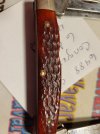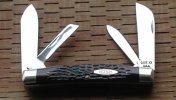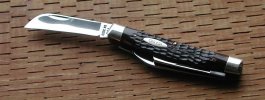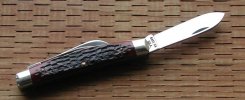- Joined
- Jan 18, 2011
- Messages
- 3,236
I'm cleaning up a knife for a neighbor. It was given to him by his late father. I am not a "traditional' collector, but I am trying to give him some information about the knife, as well.
So far, I know that it is Case XX, six dot, a large, or "jumbo", four-bladed Congress. The scales appear to be red (?) bone with carbon steel blades.
I am not sure if it is from the sixties. I think it was a very common configuration, when they were being made. Due to it's condition I don't think it is very collectable, or valuable.
I am cleaning it up, and removing the rust, but I am not sure if I should remove the patina. I don't want to buff it with my dremel because I think it may leave obvious marks.
Any additional information would be appreciated. Thanks.


So far, I know that it is Case XX, six dot, a large, or "jumbo", four-bladed Congress. The scales appear to be red (?) bone with carbon steel blades.
I am not sure if it is from the sixties. I think it was a very common configuration, when they were being made. Due to it's condition I don't think it is very collectable, or valuable.
I am cleaning it up, and removing the rust, but I am not sure if I should remove the patina. I don't want to buff it with my dremel because I think it may leave obvious marks.
Any additional information would be appreciated. Thanks.






